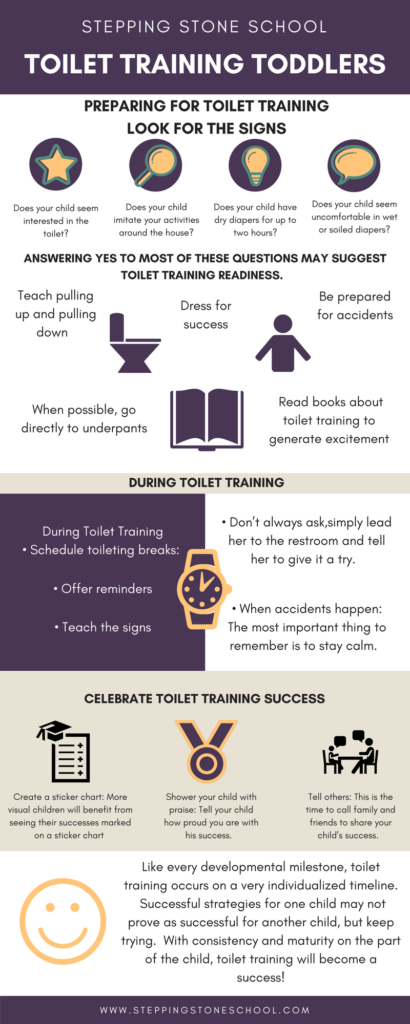Toilet Training Toddlers
It is that joyous yet challenging time in the life of a child, the moment parents trade in their child’s diapers for the coveted “big kid underpants.” Most children begin toilet training between 2 and 3 years of age, but each child will reach this developmental milestone in his or her own time.
The following provides tried and true toilet training strategies from our own Stepping Stone School toddler teachers as well as expert advice from pediatricians. Remember as you enter this stage, it is important to let your child’s classroom teacher know your intentions. Talk about the successes of your child together to provide consistency in your child’s toilet training experience. The following is formatted to assist you as you prepare for toilet training, give you strategies to apply during training, and ideas for celebrating the successes following.

Preparing for Toilet Training
Look for the signs:
Identify common indicators of toileting readiness by answering the following questions:
- Does your child seem interested in the toilet?
- Does your child imitate your activities around the house?
- Does your child have dry diapers for up to two hours?
- Does your child go to bed without a bottle?
- Does your child have regular bowel movements?
- Does your child seem uncomfortable in wet or soiled diapers?
Answering yes to most of these questions may suggest toilet training readiness.
- Teach pulling up and pulling down: Toddlers can begin learning how to pull their pants up and down. Prior to a diaper change, have your child pull his pants down while standing on the floor. After replacing your child’s diaper, bring him back down from the changing table to stand on the floor and encourage him to pull his pants back up. This practice will aide in the transition to toileting.
- When possible, go directly to underpants: Often Children will view a pull-up as a diaper and continue to use it as such. Going directly to underpants, alleviates the confusion. If your child is not quite ready for underpants, you could try putting a pull-up over top of the underpants. Doing this allows your child to feel the wet, but involves less mess to clean after an accident.
- Be prepared for accidents: When going directly to underpants, have several extra sets of clothes available. If your child has more than three accidents that first day, put the underpants away for the time being and try again in a few weeks.
- Dress for success: Remembering that toddlers involved in their play will often wait until just before it is time to use the restroom, dress your child in clothing that is loose fitting and easy for the child to pull up and down independently and quickly. Pants and leggings with elastic bands and shirts that are not so long they will dip down into a toilet.
- Read books about toilet training to generate excitement:
- My Big Girl Potty by Joanna Cole: Ashley learns to use the toilet with some help from a favorite stuffed bunny. In the boys’ version, My Big Boy Potty, Michael’s stuffed bear does the honors.
- Once Upon a Potty by Alona Frankel: Straight talk about making the big leap from diapers to potty. Available in a boys’ and girls’ version.
- The Potty Book by Alyssa Satin Capucilli: A big box contains a “big-kid” surprise for Henry (boys’ version) or Hannah (girls’ version).
- What Do You Do with a Potty? by Marianne Borgardt: An interactive book explains the toilet training process.
- When You’ve Got to Go by Janelle Kriegman and Mitchell Kriegman: Favorite characters from Bear in the Big Blue House offer kids the reassurance they need.

During Toilet Training
- Schedule toileting breaks: Set a timer to remind you when to set your child on the toilet
- Offer reminders: If your child says she does not need to go during a scheduled break, then offer her a reminder in five minutes.
- Teach the signs: If you see your child squirming indicating a need to go, help him distinguish that as the feeling he has when he needs to go to use the toilet
- Don’t always ask: If it has been a while since your child last went, simply lead her to the restroom and tell her to give it a try. Often when a child is asked if she needs to go, her reply will be “no.”
- When accidents happen: The most important thing to remember is to stay When your child does have an accident, do not shame him or discourage him, simply say, “You forgot this time, but I know you’ll make it to thepotty next time.”
Celebrate Toilet Training Success
- Shower your child with praise: Tell your child how proud you are with his success. Remind him how he recognized he needed to use the toilet and he made it there on time. Getting specific with your praise reinforces what your child has already learned about how to be successful next time.
- Create a sticker chart: More visual children will benefit from seeing their successes marked on a sticker chart of some kind. Set a goal to obtain a certain number of stickers and celebrate when that goal has been met.
- Tell others: This is the time to call family and friends to share your child’s success.
Like every developmental milestone, toilet training occurs on a very individualized timeline. Successful strategies for one child may not prove as successful for another child, but keep trying. With consistency and maturity on the part of the child, toilet training will become a success!
References:
Dewar, G. (2014). Potty training techniques: A evidence-based guide to training methods and their success rates. Retrieved from http://www.parentingscience.com/potty-training-techniques.html
Janes, E. (2013, Nov. 6). “Potty training: 10 steps to teaching your toddler.” Today Parents. Retrieved from http://www.today.com/parents/potty-training-10-steps-toilet-teaching-your-toddler-I144971
“Potty training: 7 experts’ tips from daycare teachers.” Retrieved from http://www.todaysparent.com/toddler/potty-training/how-daycares-make-diapers-disappear/
SmartParentingAdvice.com is another fantastic resource for Toilet Training Toddlers.